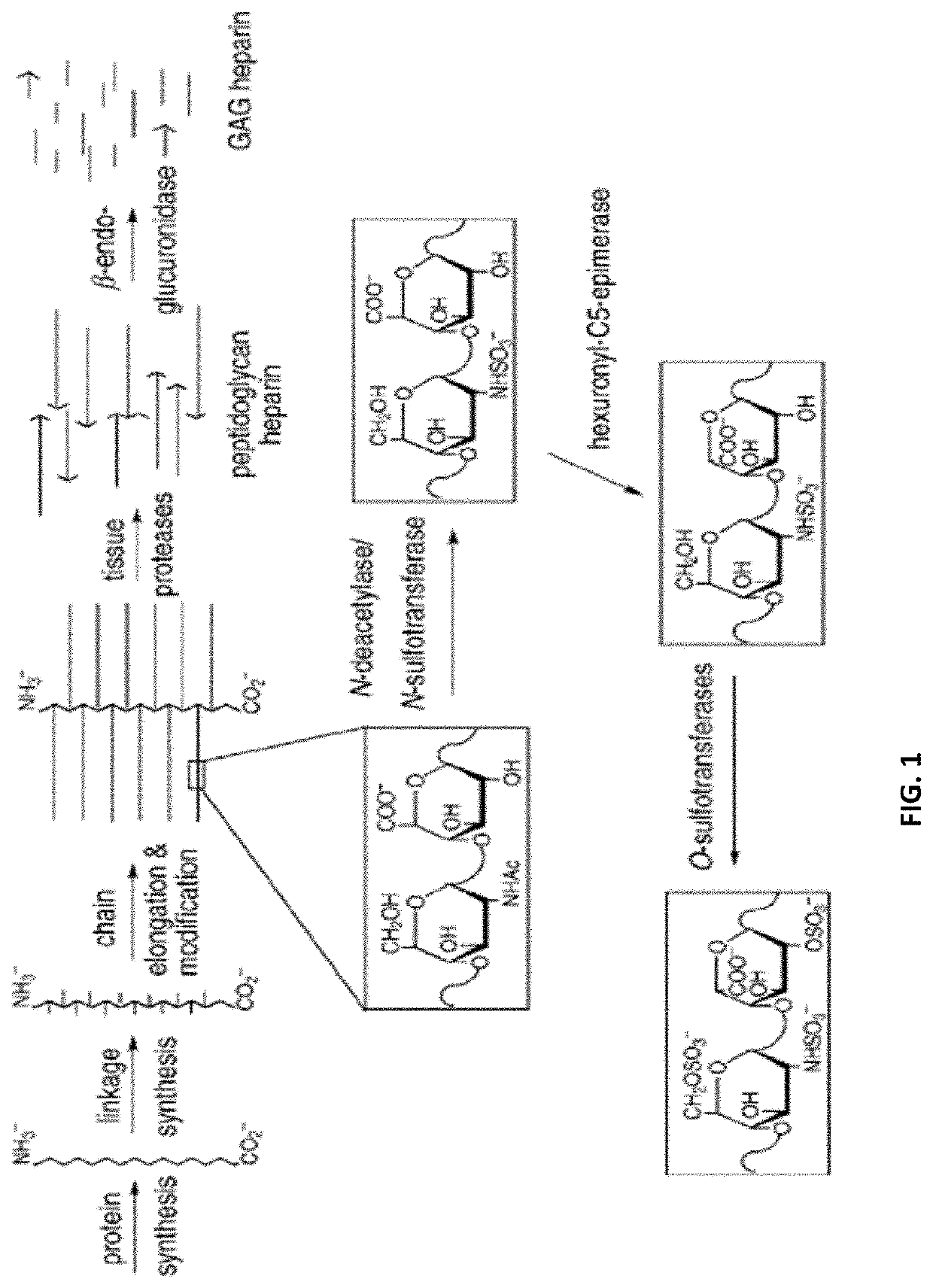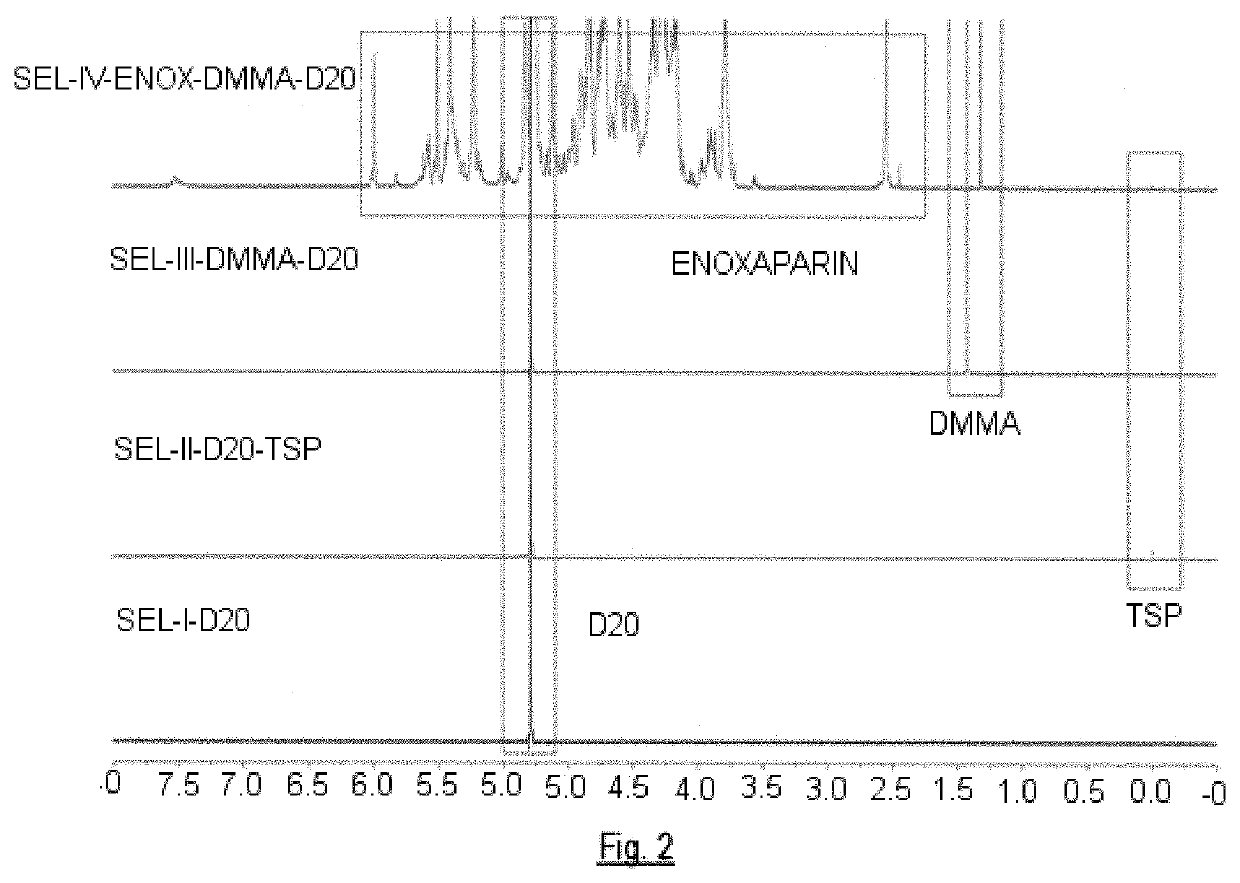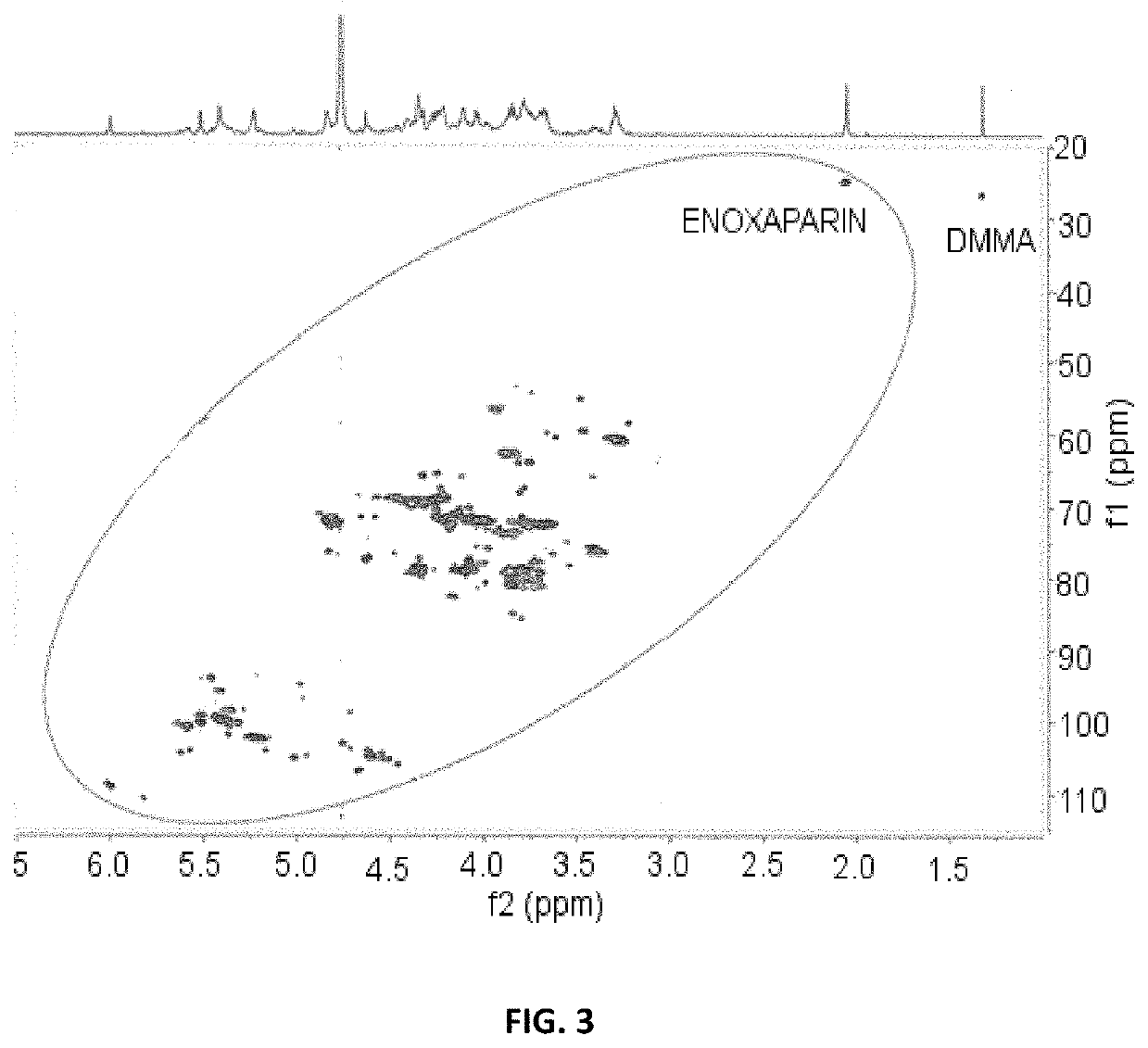Method for the Analysis of Glycosaminoglycans, and Their Derivatives and Salts by Nuclear Magnetic Resonance
a glycosaminoglycan and nuclear magnetic resonance technology, applied in the direction of analysis using nuclear magnetic resonance, measurement using nmr, instruments, etc., can solve the problems of inability to obtain structural information directly from this area, the complete characterization of heparins and low molecular weight heparins is currently a challenge, and the difficulty of obtaining structural information prior to this area
- Summary
- Abstract
- Description
- Claims
- Application Information
AI Technical Summary
Benefits of technology
Problems solved by technology
Method used
Image
Examples
example 1
1H NMR of Enoxaparin Sodium
[0219]Enoxaparin sodium (50 mg) are dissolved in 500 μL of a D2O-TSP (solution B) solution. Then 100 μL of DMMA solution (solution C) are added. The resulting solution is introduced in a 5 mm diameter tube.
[0220]The resulting DMMA concentration in the solution is 1.5 mM. The experiments are performed on a Bruker AVIII-800 nuclear magnetic resonance spectrometer. The main signals identified are as follows:
SignalChemical shift, ppmH4 ΔU2S5.992H4 ΔU25.825H1 1,6-AnA5.616H1 ANS(-G)5.585H1 1,6-AnM5.569H1 ΔU2S5.509H1 ANS6S5.405H1 I2S5.228H1 I5.012H5 I2S4.836H1 G4.628H6 ANS6S4.344H6′ ANS6S4.210H3 ANS3.670H2 ANS3S3.395H2 ANS3.293NAc2.047DMMA1.320TSP0.069
[0221]Once the values of the integrals of the signals both of DMMA and the rest of the residues have been obtained, the normalized values are obtained of said residues dividing the value of its integrals by the value of the integral corresponding to the DMMA signal. This normalization can be performed, because the c...
example 2
[0228]The same solution used in Example 1 is used to perform the study by 1H-13C HSQC. The main signals identified are as follows:
Signalδ13C, ppmδ1H, ppmSignalδ13C, ppmδ1H, ppmC4—H4 ΔU110.715.82C3—H3 Gal85.453.78C4—H4 ΔU2S108.975.99C3—H3 Gal84.853.83C1—H1 G / / Gal106.624.66C4—H4 ANS6S(-G) / / 80.943.84C1—H1 Xyl105.794.45ANS6S redC1—H1 G(-ANAc)105.134.50C2—H2 I2S78.534.34C1—H1 I(-A6S)104.945.01C3—H3 Xyl77.823.72C1—H1 G(-ANS)104.774.60C2—H2 ΔU2S77.424.62C1—H1 I(-A6OH)104.674.94C2—H2 G(-AN6S)75.703.40C1—H1 Gal104.304.54C3—H3 ANS6S (-G)72.473.66C1—H1 1,6-an.A104.225.61C3—H3 ANS6S red72.293.77C1—H1 G(-ANS3S)103.914.61C5—H5 I2S72.014.83C1—H1 1,6-an.M103.915.57C3—H3 I2S71.874.21C1—H1 ΔU103.885.16C5—H5 ANS6S(-G)71.724.09C1—H1 G2S102.994.75C5—H5 MNS6S red70.984.15C1—H1_I2S102.095.22C5—H5 ANS6S red70.644.12C1—H1 I2S(-1,6-101.595.36C6—H6 1,6-an.A / / 67.533.77an.M)1,6-an.MC1—H1 ANS(-G)100.505.58C5—H5 Xyl65.894.12C1—H1 ANAc100.235.31C5—H5 Xyl65.863.40C1—H1 ΔU2S100.185.51C3—H3 ΔU2S65.754.32C1—H1 ANS...
example 3
Study by 1H NMR of Bemiparin Sodium
[0232]The main 1H chemical shift signals identified were as follows:
SignalChemical shift, ppmH4 ΔU2S5.992H4 ΔU5.825H1 1,6-AnA5.616H1 ANS(-G)5.585H1 1,6-AnM5.569H1 ΔU2S5.509H1 ANS6S5.405H1 I2S5.228H1 I5.012H5 I2S4.836H1 G4.628H6 ANS6S4.344H6′ ANS6S4.210H3 ANS3.670H2 ANS3S3.395H2 ANS3.293NAc2.047DMMA1.320TSP0.069
[0233]The quantification of the characteristic and well-differentiated signals of bemiparin sodium (generally those corresponding to the anomeric or target protons, H1) are shown in the following table, with the values of relative proportions observed for a series of six samples.
SignalChemical shift, ppmRelative proportion, %H4 ΔU2S5.993.7-5.7H4 ΔU5.820.2-2.5H1 1,6-an.A5.620.5-2.5H1 1,6-an.M5.572.5-6.0H1 ΔU2S5.51 7.0-10.7H1 ANS6S5.4019.0-21.3H1 I2S5.2313.8-18.5H2 ANS3.2918.7-26.3NAc2.05 9.4-14.4
PUM
 Login to View More
Login to View More Abstract
Description
Claims
Application Information
 Login to View More
Login to View More - R&D
- Intellectual Property
- Life Sciences
- Materials
- Tech Scout
- Unparalleled Data Quality
- Higher Quality Content
- 60% Fewer Hallucinations
Browse by: Latest US Patents, China's latest patents, Technical Efficacy Thesaurus, Application Domain, Technology Topic, Popular Technical Reports.
© 2025 PatSnap. All rights reserved.Legal|Privacy policy|Modern Slavery Act Transparency Statement|Sitemap|About US| Contact US: help@patsnap.com



